A Detailed Analysis of Leadership, Management, and Operations at M&S
VerifiedAdded on 2021/01/01
|13
|4132
|265
Report
AI Summary
This report provides a comprehensive analysis of the management and operations of Mark & Spencer (M&S). It begins with an introduction to operations management and the chosen company, M&S, discussing its founding and business sector. The report delves into the roles of leaders and managers, highlighting their characteristics and differences, and examines the managerial functions of planning, organizing, staffing, directing, and controlling. It explores various leadership theories, including situational, systems, and contingency theories, assessing their strengths and weaknesses. Furthermore, the report covers procedures for redesigning goods and services in business operations, focusing on key approaches such as Total Quality Management, Just-in-Time, Six Sigma, and Lean Production, with an emphasis on their benefits for M&S. The report concludes with a summary of its findings and references used.
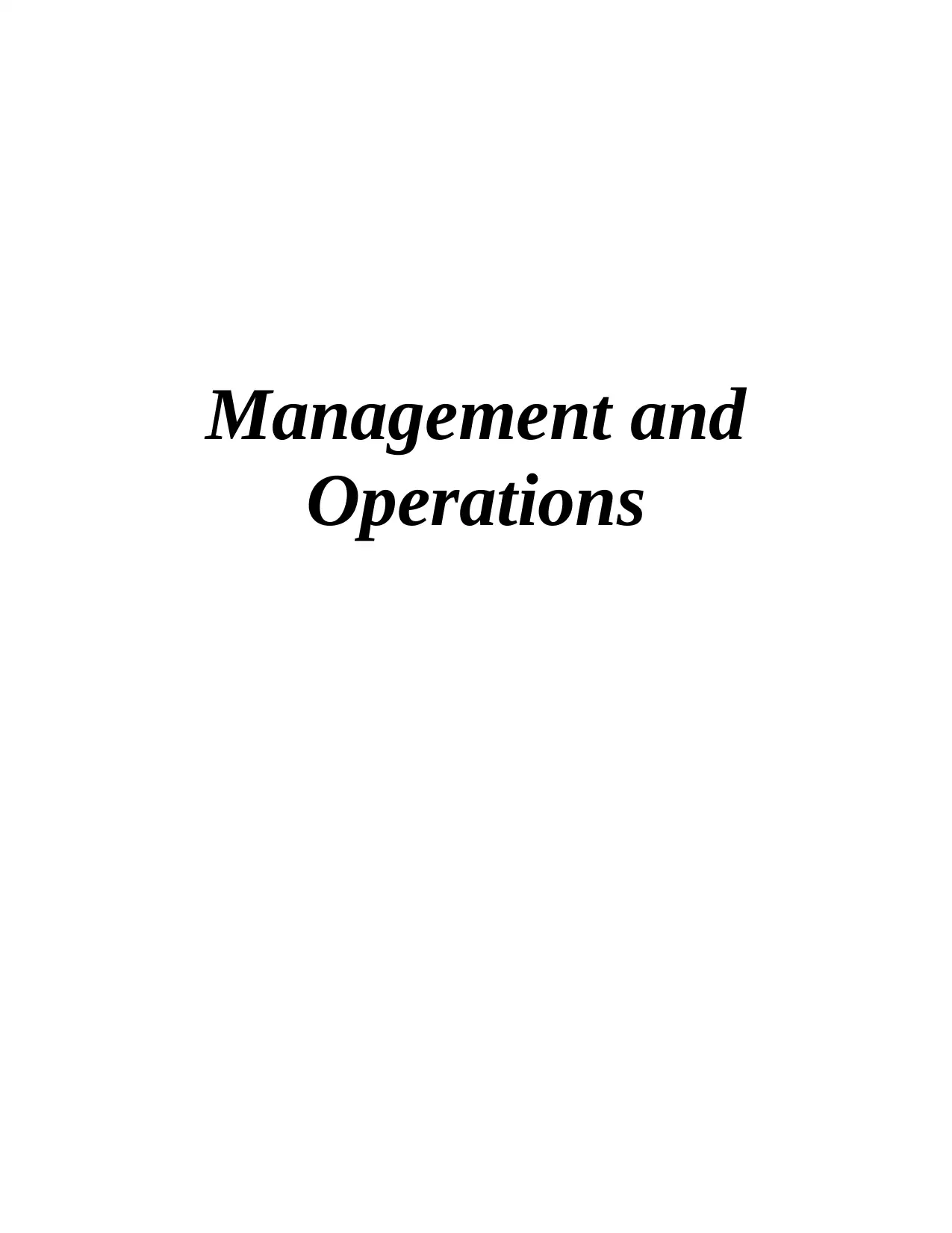
Management and
Operations
Operations
Paraphrase This Document
Need a fresh take? Get an instant paraphrase of this document with our AI Paraphraser
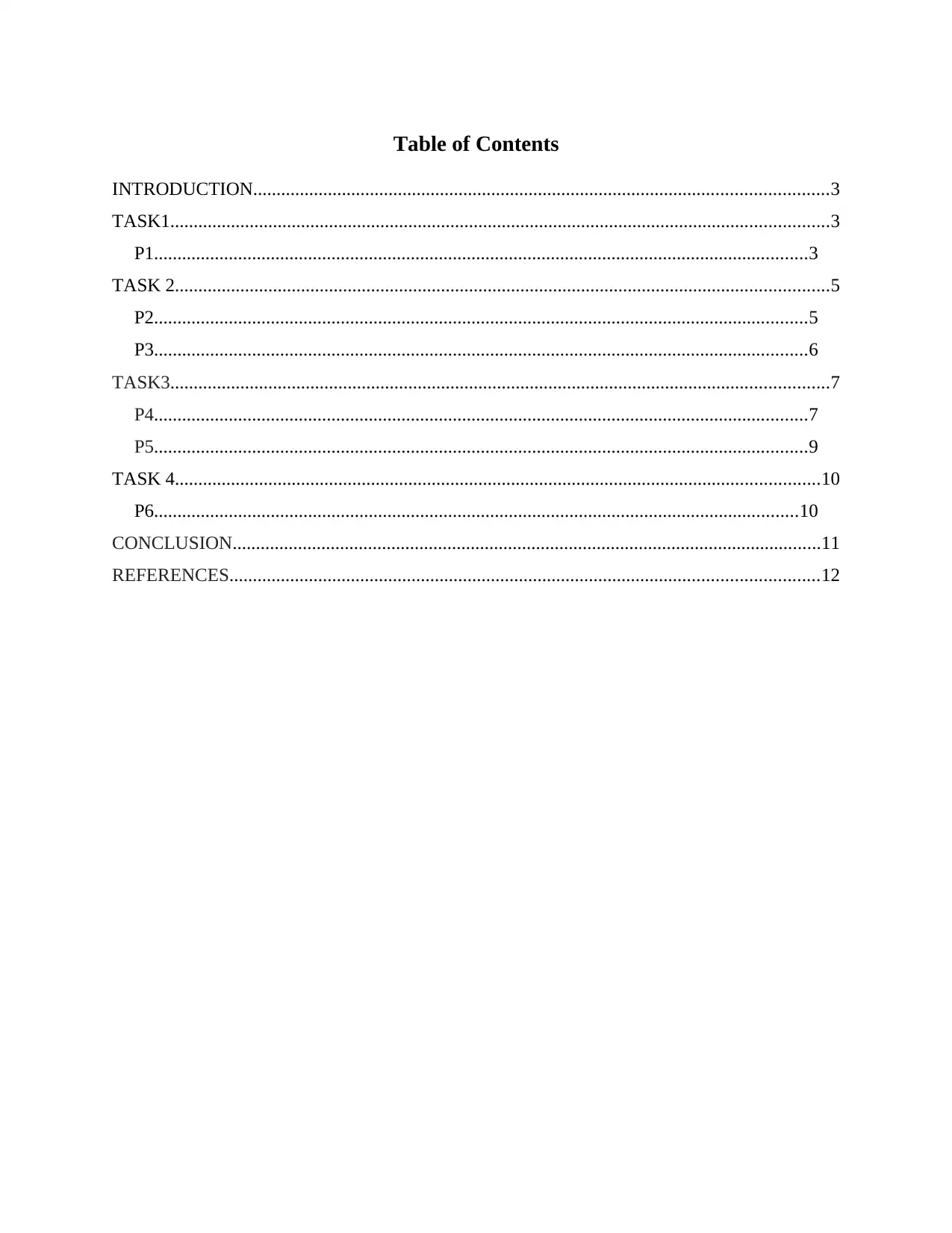
Table of Contents
INTRODUCTION...........................................................................................................................3
TASK1.............................................................................................................................................3
P1............................................................................................................................................3
TASK 2............................................................................................................................................5
P2............................................................................................................................................5
P3............................................................................................................................................6
TASK3.............................................................................................................................................7
P4............................................................................................................................................7
P5............................................................................................................................................9
TASK 4..........................................................................................................................................10
P6..........................................................................................................................................10
CONCLUSION..............................................................................................................................11
REFERENCES..............................................................................................................................12
INTRODUCTION...........................................................................................................................3
TASK1.............................................................................................................................................3
P1............................................................................................................................................3
TASK 2............................................................................................................................................5
P2............................................................................................................................................5
P3............................................................................................................................................6
TASK3.............................................................................................................................................7
P4............................................................................................................................................7
P5............................................................................................................................................9
TASK 4..........................................................................................................................................10
P6..........................................................................................................................................10
CONCLUSION..............................................................................................................................11
REFERENCES..............................................................................................................................12
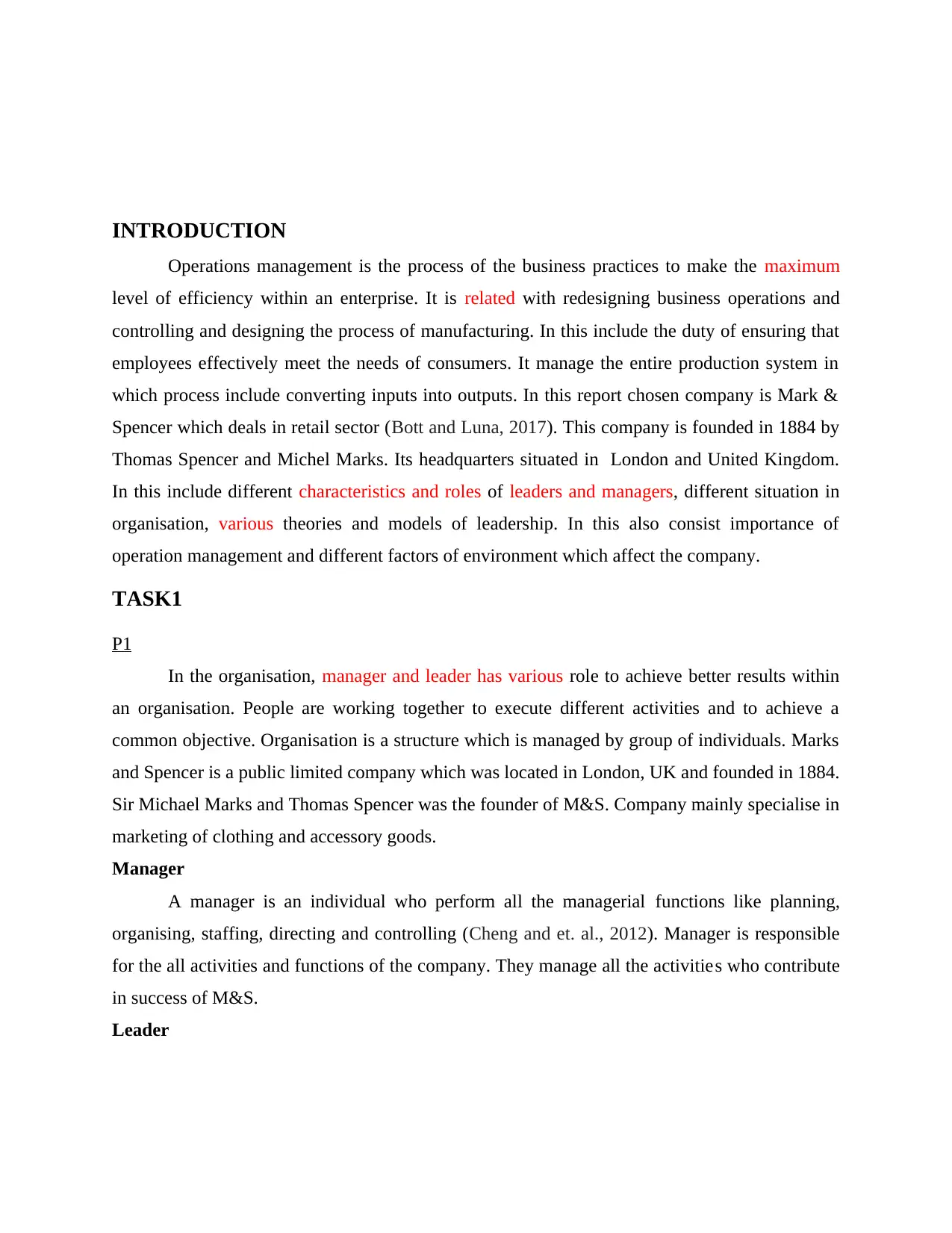
INTRODUCTION
Operations management is the process of the business practices to make the maximum
level of efficiency within an enterprise. It is related with redesigning business operations and
controlling and designing the process of manufacturing. In this include the duty of ensuring that
employees effectively meet the needs of consumers. It manage the entire production system in
which process include converting inputs into outputs. In this report chosen company is Mark &
Spencer which deals in retail sector (Bott and Luna, 2017). This company is founded in 1884 by
Thomas Spencer and Michel Marks. Its headquarters situated in London and United Kingdom.
In this include different characteristics and roles of leaders and managers, different situation in
organisation, various theories and models of leadership. In this also consist importance of
operation management and different factors of environment which affect the company.
TASK1
P1
In the organisation, manager and leader has various role to achieve better results within
an organisation. People are working together to execute different activities and to achieve a
common objective. Organisation is a structure which is managed by group of individuals. Marks
and Spencer is a public limited company which was located in London, UK and founded in 1884.
Sir Michael Marks and Thomas Spencer was the founder of M&S. Company mainly specialise in
marketing of clothing and accessory goods.
Manager
A manager is an individual who perform all the managerial functions like planning,
organising, staffing, directing and controlling (Cheng and et. al., 2012). Manager is responsible
for the all activities and functions of the company. They manage all the activities who contribute
in success of M&S.
Leader
Operations management is the process of the business practices to make the maximum
level of efficiency within an enterprise. It is related with redesigning business operations and
controlling and designing the process of manufacturing. In this include the duty of ensuring that
employees effectively meet the needs of consumers. It manage the entire production system in
which process include converting inputs into outputs. In this report chosen company is Mark &
Spencer which deals in retail sector (Bott and Luna, 2017). This company is founded in 1884 by
Thomas Spencer and Michel Marks. Its headquarters situated in London and United Kingdom.
In this include different characteristics and roles of leaders and managers, different situation in
organisation, various theories and models of leadership. In this also consist importance of
operation management and different factors of environment which affect the company.
TASK1
P1
In the organisation, manager and leader has various role to achieve better results within
an organisation. People are working together to execute different activities and to achieve a
common objective. Organisation is a structure which is managed by group of individuals. Marks
and Spencer is a public limited company which was located in London, UK and founded in 1884.
Sir Michael Marks and Thomas Spencer was the founder of M&S. Company mainly specialise in
marketing of clothing and accessory goods.
Manager
A manager is an individual who perform all the managerial functions like planning,
organising, staffing, directing and controlling (Cheng and et. al., 2012). Manager is responsible
for the all activities and functions of the company. They manage all the activities who contribute
in success of M&S.
Leader
⊘ This is a preview!⊘
Do you want full access?
Subscribe today to unlock all pages.

Trusted by 1+ million students worldwide
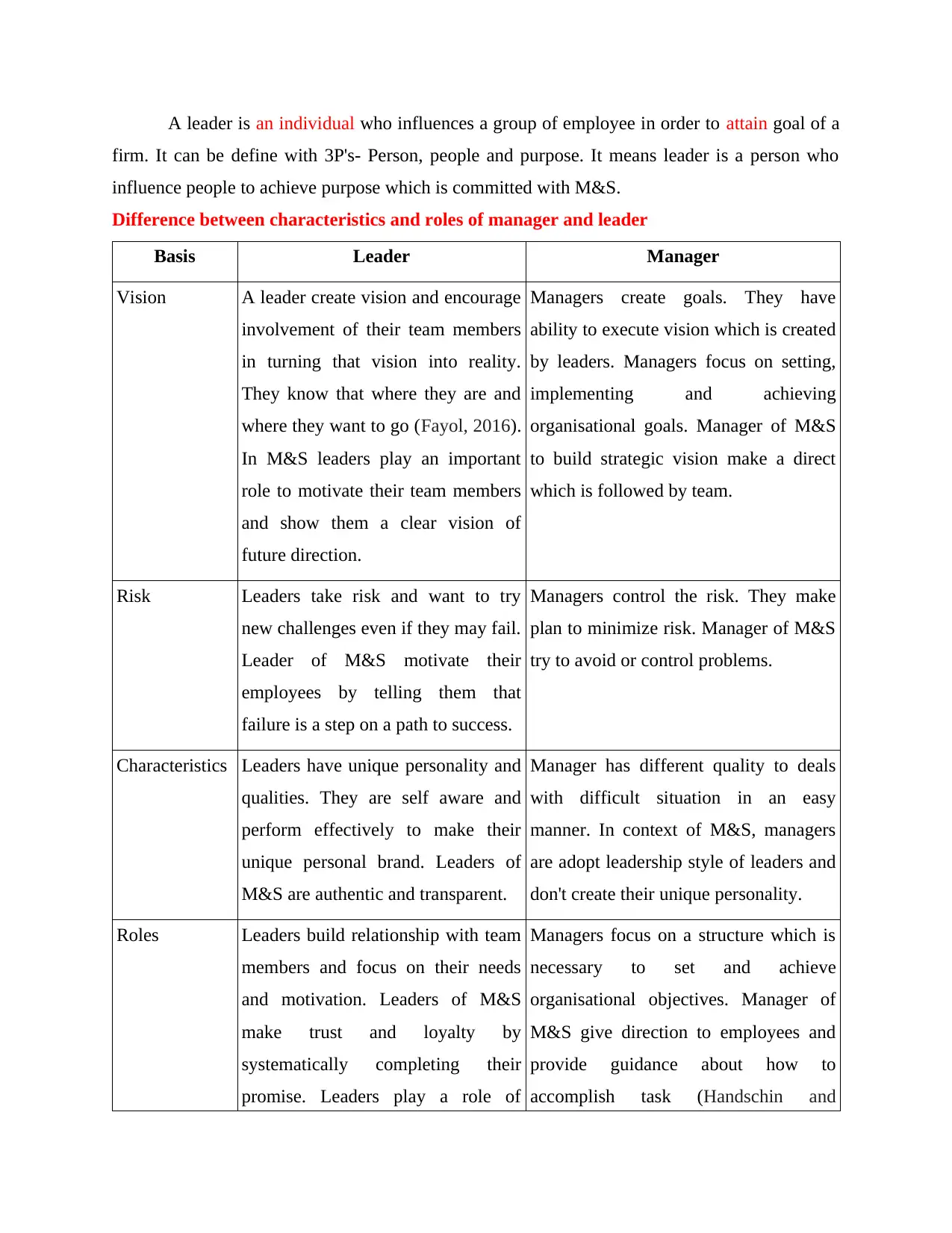
A leader is an individual who influences a group of employee in order to attain goal of a
firm. It can be define with 3P's- Person, people and purpose. It means leader is a person who
influence people to achieve purpose which is committed with M&S.
Difference between characteristics and roles of manager and leader
Basis Leader Manager
Vision A leader create vision and encourage
involvement of their team members
in turning that vision into reality.
They know that where they are and
where they want to go (Fayol, 2016).
In M&S leaders play an important
role to motivate their team members
and show them a clear vision of
future direction.
Managers create goals. They have
ability to execute vision which is created
by leaders. Managers focus on setting,
implementing and achieving
organisational goals. Manager of M&S
to build strategic vision make a direct
which is followed by team.
Risk Leaders take risk and want to try
new challenges even if they may fail.
Leader of M&S motivate their
employees by telling them that
failure is a step on a path to success.
Managers control the risk. They make
plan to minimize risk. Manager of M&S
try to avoid or control problems.
Characteristics Leaders have unique personality and
qualities. They are self aware and
perform effectively to make their
unique personal brand. Leaders of
M&S are authentic and transparent.
Manager has different quality to deals
with difficult situation in an easy
manner. In context of M&S, managers
are adopt leadership style of leaders and
don't create their unique personality.
Roles Leaders build relationship with team
members and focus on their needs
and motivation. Leaders of M&S
make trust and loyalty by
systematically completing their
promise. Leaders play a role of
Managers focus on a structure which is
necessary to set and achieve
organisational objectives. Manager of
M&S give direction to employees and
provide guidance about how to
accomplish task (Handschin and
firm. It can be define with 3P's- Person, people and purpose. It means leader is a person who
influence people to achieve purpose which is committed with M&S.
Difference between characteristics and roles of manager and leader
Basis Leader Manager
Vision A leader create vision and encourage
involvement of their team members
in turning that vision into reality.
They know that where they are and
where they want to go (Fayol, 2016).
In M&S leaders play an important
role to motivate their team members
and show them a clear vision of
future direction.
Managers create goals. They have
ability to execute vision which is created
by leaders. Managers focus on setting,
implementing and achieving
organisational goals. Manager of M&S
to build strategic vision make a direct
which is followed by team.
Risk Leaders take risk and want to try
new challenges even if they may fail.
Leader of M&S motivate their
employees by telling them that
failure is a step on a path to success.
Managers control the risk. They make
plan to minimize risk. Manager of M&S
try to avoid or control problems.
Characteristics Leaders have unique personality and
qualities. They are self aware and
perform effectively to make their
unique personal brand. Leaders of
M&S are authentic and transparent.
Manager has different quality to deals
with difficult situation in an easy
manner. In context of M&S, managers
are adopt leadership style of leaders and
don't create their unique personality.
Roles Leaders build relationship with team
members and focus on their needs
and motivation. Leaders of M&S
make trust and loyalty by
systematically completing their
promise. Leaders play a role of
Managers focus on a structure which is
necessary to set and achieve
organisational objectives. Manager of
M&S give direction to employees and
provide guidance about how to
accomplish task (Handschin and
Paraphrase This Document
Need a fresh take? Get an instant paraphrase of this document with our AI Paraphraser
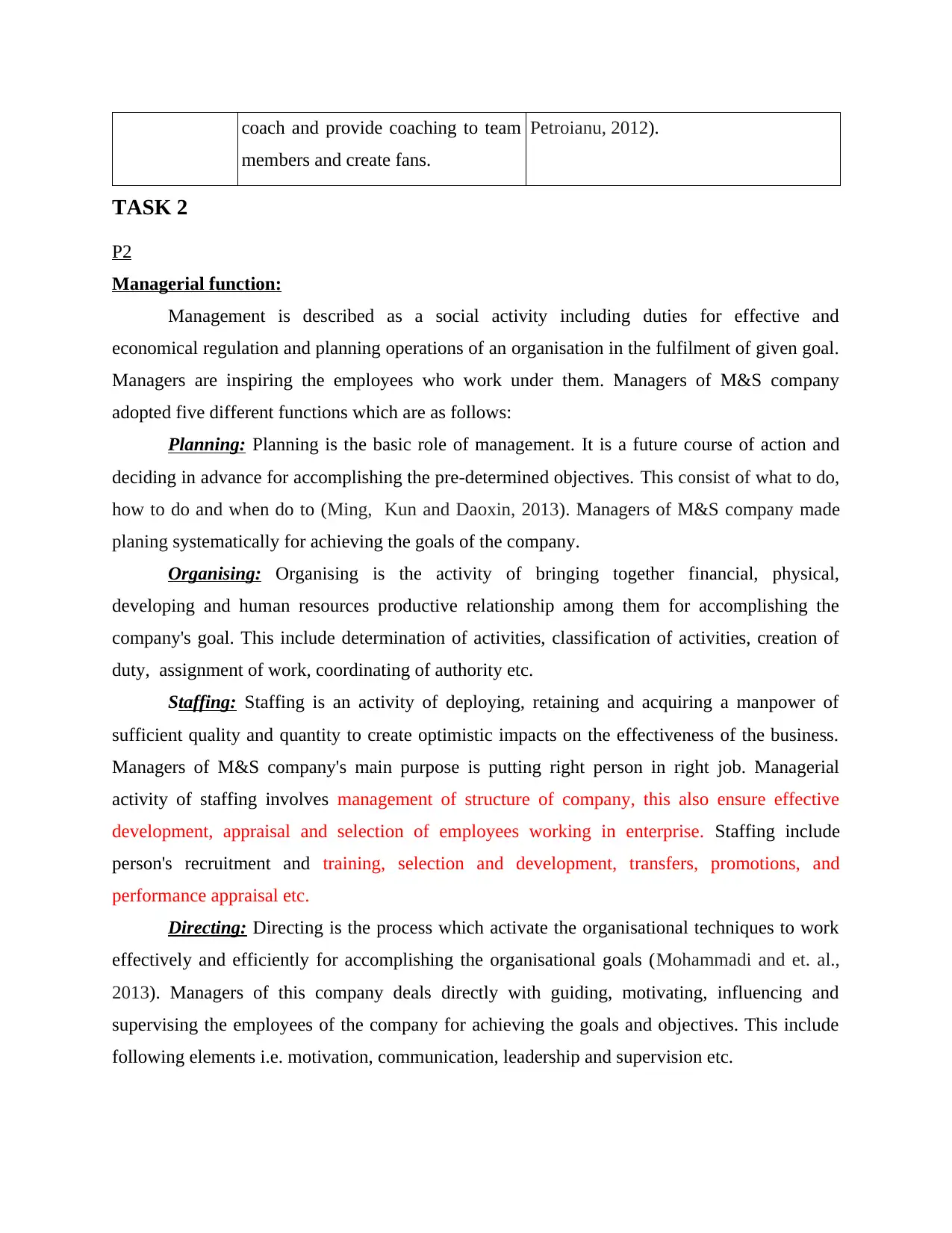
coach and provide coaching to team
members and create fans.
Petroianu, 2012).
TASK 2
P2
Managerial function:
Management is described as a social activity including duties for effective and
economical regulation and planning operations of an organisation in the fulfilment of given goal.
Managers are inspiring the employees who work under them. Managers of M&S company
adopted five different functions which are as follows:
Planning: Planning is the basic role of management. It is a future course of action and
deciding in advance for accomplishing the pre-determined objectives. This consist of what to do,
how to do and when do to (Ming, Kun and Daoxin, 2013). Managers of M&S company made
planing systematically for achieving the goals of the company.
Organising: Organising is the activity of bringing together financial, physical,
developing and human resources productive relationship among them for accomplishing the
company's goal. This include determination of activities, classification of activities, creation of
duty, assignment of work, coordinating of authority etc.
Staffing: Staffing is an activity of deploying, retaining and acquiring a manpower of
sufficient quality and quantity to create optimistic impacts on the effectiveness of the business.
Managers of M&S company's main purpose is putting right person in right job. Managerial
activity of staffing involves management of structure of company, this also ensure effective
development, appraisal and selection of employees working in enterprise. Staffing include
person's recruitment and training, selection and development, transfers, promotions, and
performance appraisal etc.
Directing: Directing is the process which activate the organisational techniques to work
effectively and efficiently for accomplishing the organisational goals (Mohammadi and et. al.,
2013). Managers of this company deals directly with guiding, motivating, influencing and
supervising the employees of the company for achieving the goals and objectives. This include
following elements i.e. motivation, communication, leadership and supervision etc.
members and create fans.
Petroianu, 2012).
TASK 2
P2
Managerial function:
Management is described as a social activity including duties for effective and
economical regulation and planning operations of an organisation in the fulfilment of given goal.
Managers are inspiring the employees who work under them. Managers of M&S company
adopted five different functions which are as follows:
Planning: Planning is the basic role of management. It is a future course of action and
deciding in advance for accomplishing the pre-determined objectives. This consist of what to do,
how to do and when do to (Ming, Kun and Daoxin, 2013). Managers of M&S company made
planing systematically for achieving the goals of the company.
Organising: Organising is the activity of bringing together financial, physical,
developing and human resources productive relationship among them for accomplishing the
company's goal. This include determination of activities, classification of activities, creation of
duty, assignment of work, coordinating of authority etc.
Staffing: Staffing is an activity of deploying, retaining and acquiring a manpower of
sufficient quality and quantity to create optimistic impacts on the effectiveness of the business.
Managers of M&S company's main purpose is putting right person in right job. Managerial
activity of staffing involves management of structure of company, this also ensure effective
development, appraisal and selection of employees working in enterprise. Staffing include
person's recruitment and training, selection and development, transfers, promotions, and
performance appraisal etc.
Directing: Directing is the process which activate the organisational techniques to work
effectively and efficiently for accomplishing the organisational goals (Mohammadi and et. al.,
2013). Managers of this company deals directly with guiding, motivating, influencing and
supervising the employees of the company for achieving the goals and objectives. This include
following elements i.e. motivation, communication, leadership and supervision etc.
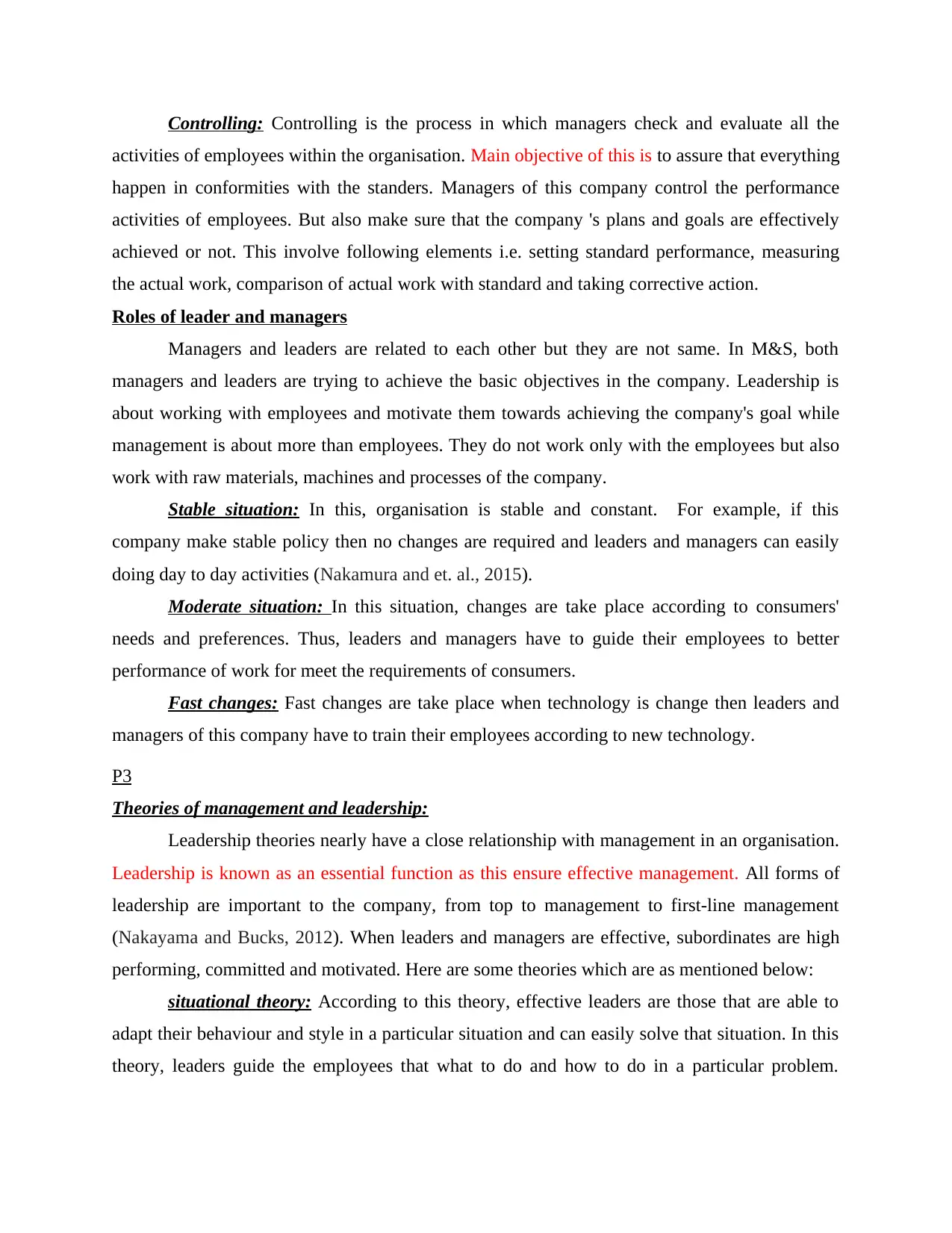
Controlling: Controlling is the process in which managers check and evaluate all the
activities of employees within the organisation. Main objective of this is to assure that everything
happen in conformities with the standers. Managers of this company control the performance
activities of employees. But also make sure that the company 's plans and goals are effectively
achieved or not. This involve following elements i.e. setting standard performance, measuring
the actual work, comparison of actual work with standard and taking corrective action.
Roles of leader and managers
Managers and leaders are related to each other but they are not same. In M&S, both
managers and leaders are trying to achieve the basic objectives in the company. Leadership is
about working with employees and motivate them towards achieving the company's goal while
management is about more than employees. They do not work only with the employees but also
work with raw materials, machines and processes of the company.
Stable situation: In this, organisation is stable and constant. For example, if this
company make stable policy then no changes are required and leaders and managers can easily
doing day to day activities (Nakamura and et. al., 2015).
Moderate situation: In this situation, changes are take place according to consumers'
needs and preferences. Thus, leaders and managers have to guide their employees to better
performance of work for meet the requirements of consumers.
Fast changes: Fast changes are take place when technology is change then leaders and
managers of this company have to train their employees according to new technology.
P3
Theories of management and leadership:
Leadership theories nearly have a close relationship with management in an organisation.
Leadership is known as an essential function as this ensure effective management. All forms of
leadership are important to the company, from top to management to first-line management
(Nakayama and Bucks, 2012). When leaders and managers are effective, subordinates are high
performing, committed and motivated. Here are some theories which are as mentioned below:
situational theory: According to this theory, effective leaders are those that are able to
adapt their behaviour and style in a particular situation and can easily solve that situation. In this
theory, leaders guide the employees that what to do and how to do in a particular problem.
activities of employees within the organisation. Main objective of this is to assure that everything
happen in conformities with the standers. Managers of this company control the performance
activities of employees. But also make sure that the company 's plans and goals are effectively
achieved or not. This involve following elements i.e. setting standard performance, measuring
the actual work, comparison of actual work with standard and taking corrective action.
Roles of leader and managers
Managers and leaders are related to each other but they are not same. In M&S, both
managers and leaders are trying to achieve the basic objectives in the company. Leadership is
about working with employees and motivate them towards achieving the company's goal while
management is about more than employees. They do not work only with the employees but also
work with raw materials, machines and processes of the company.
Stable situation: In this, organisation is stable and constant. For example, if this
company make stable policy then no changes are required and leaders and managers can easily
doing day to day activities (Nakamura and et. al., 2015).
Moderate situation: In this situation, changes are take place according to consumers'
needs and preferences. Thus, leaders and managers have to guide their employees to better
performance of work for meet the requirements of consumers.
Fast changes: Fast changes are take place when technology is change then leaders and
managers of this company have to train their employees according to new technology.
P3
Theories of management and leadership:
Leadership theories nearly have a close relationship with management in an organisation.
Leadership is known as an essential function as this ensure effective management. All forms of
leadership are important to the company, from top to management to first-line management
(Nakayama and Bucks, 2012). When leaders and managers are effective, subordinates are high
performing, committed and motivated. Here are some theories which are as mentioned below:
situational theory: According to this theory, effective leaders are those that are able to
adapt their behaviour and style in a particular situation and can easily solve that situation. In this
theory, leaders guide the employees that what to do and how to do in a particular problem.
⊘ This is a preview!⊘
Do you want full access?
Subscribe today to unlock all pages.

Trusted by 1+ million students worldwide
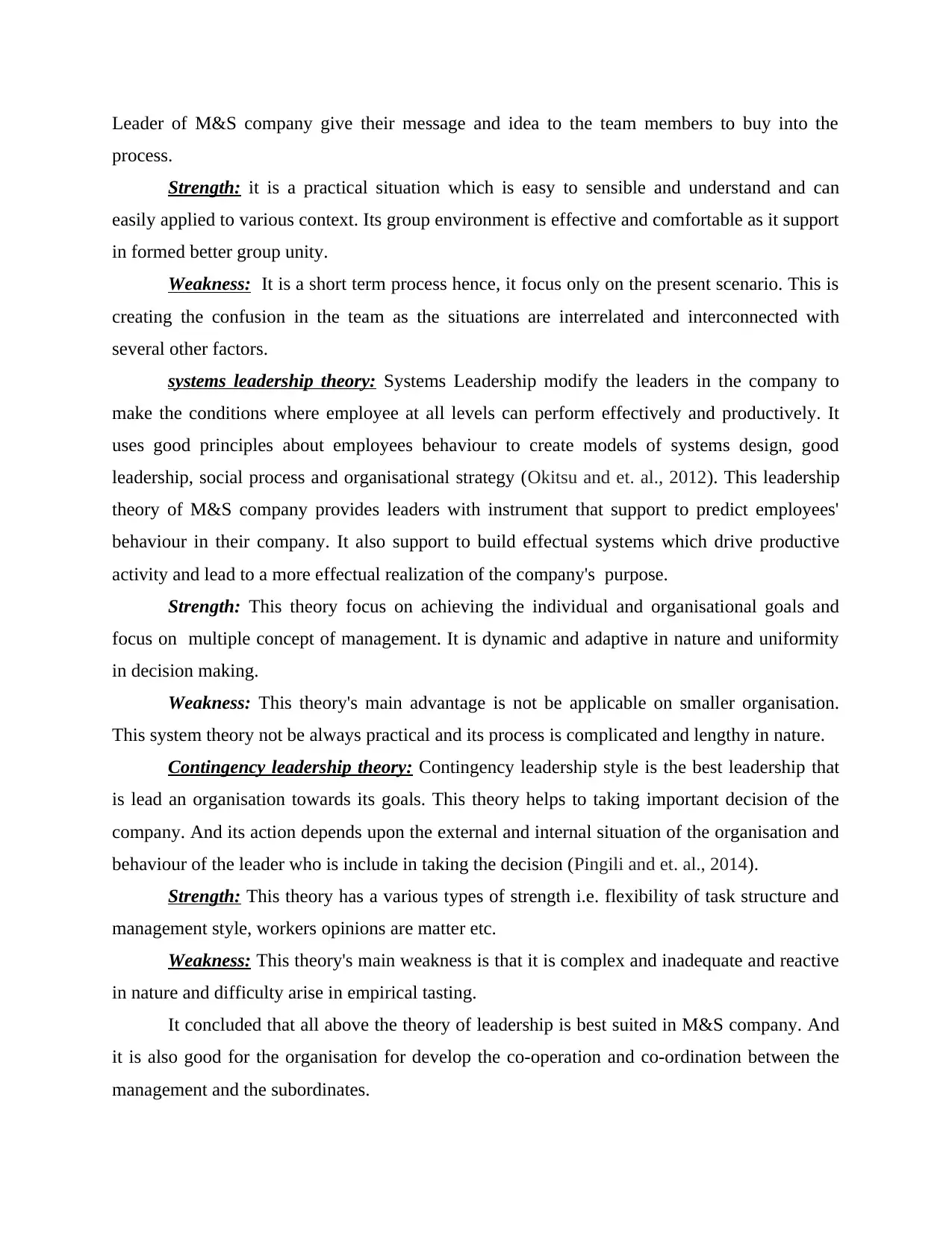
Leader of M&S company give their message and idea to the team members to buy into the
process.
Strength: it is a practical situation which is easy to sensible and understand and can
easily applied to various context. Its group environment is effective and comfortable as it support
in formed better group unity.
Weakness: It is a short term process hence, it focus only on the present scenario. This is
creating the confusion in the team as the situations are interrelated and interconnected with
several other factors.
systems leadership theory: Systems Leadership modify the leaders in the company to
make the conditions where employee at all levels can perform effectively and productively. It
uses good principles about employees behaviour to create models of systems design, good
leadership, social process and organisational strategy (Okitsu and et. al., 2012). This leadership
theory of M&S company provides leaders with instrument that support to predict employees'
behaviour in their company. It also support to build effectual systems which drive productive
activity and lead to a more effectual realization of the company's purpose.
Strength: This theory focus on achieving the individual and organisational goals and
focus on multiple concept of management. It is dynamic and adaptive in nature and uniformity
in decision making.
Weakness: This theory's main advantage is not be applicable on smaller organisation.
This system theory not be always practical and its process is complicated and lengthy in nature.
Contingency leadership theory: Contingency leadership style is the best leadership that
is lead an organisation towards its goals. This theory helps to taking important decision of the
company. And its action depends upon the external and internal situation of the organisation and
behaviour of the leader who is include in taking the decision (Pingili and et. al., 2014).
Strength: This theory has a various types of strength i.e. flexibility of task structure and
management style, workers opinions are matter etc.
Weakness: This theory's main weakness is that it is complex and inadequate and reactive
in nature and difficulty arise in empirical tasting.
It concluded that all above the theory of leadership is best suited in M&S company. And
it is also good for the organisation for develop the co-operation and co-ordination between the
management and the subordinates.
process.
Strength: it is a practical situation which is easy to sensible and understand and can
easily applied to various context. Its group environment is effective and comfortable as it support
in formed better group unity.
Weakness: It is a short term process hence, it focus only on the present scenario. This is
creating the confusion in the team as the situations are interrelated and interconnected with
several other factors.
systems leadership theory: Systems Leadership modify the leaders in the company to
make the conditions where employee at all levels can perform effectively and productively. It
uses good principles about employees behaviour to create models of systems design, good
leadership, social process and organisational strategy (Okitsu and et. al., 2012). This leadership
theory of M&S company provides leaders with instrument that support to predict employees'
behaviour in their company. It also support to build effectual systems which drive productive
activity and lead to a more effectual realization of the company's purpose.
Strength: This theory focus on achieving the individual and organisational goals and
focus on multiple concept of management. It is dynamic and adaptive in nature and uniformity
in decision making.
Weakness: This theory's main advantage is not be applicable on smaller organisation.
This system theory not be always practical and its process is complicated and lengthy in nature.
Contingency leadership theory: Contingency leadership style is the best leadership that
is lead an organisation towards its goals. This theory helps to taking important decision of the
company. And its action depends upon the external and internal situation of the organisation and
behaviour of the leader who is include in taking the decision (Pingili and et. al., 2014).
Strength: This theory has a various types of strength i.e. flexibility of task structure and
management style, workers opinions are matter etc.
Weakness: This theory's main weakness is that it is complex and inadequate and reactive
in nature and difficulty arise in empirical tasting.
It concluded that all above the theory of leadership is best suited in M&S company. And
it is also good for the organisation for develop the co-operation and co-ordination between the
management and the subordinates.
Paraphrase This Document
Need a fresh take? Get an instant paraphrase of this document with our AI Paraphraser
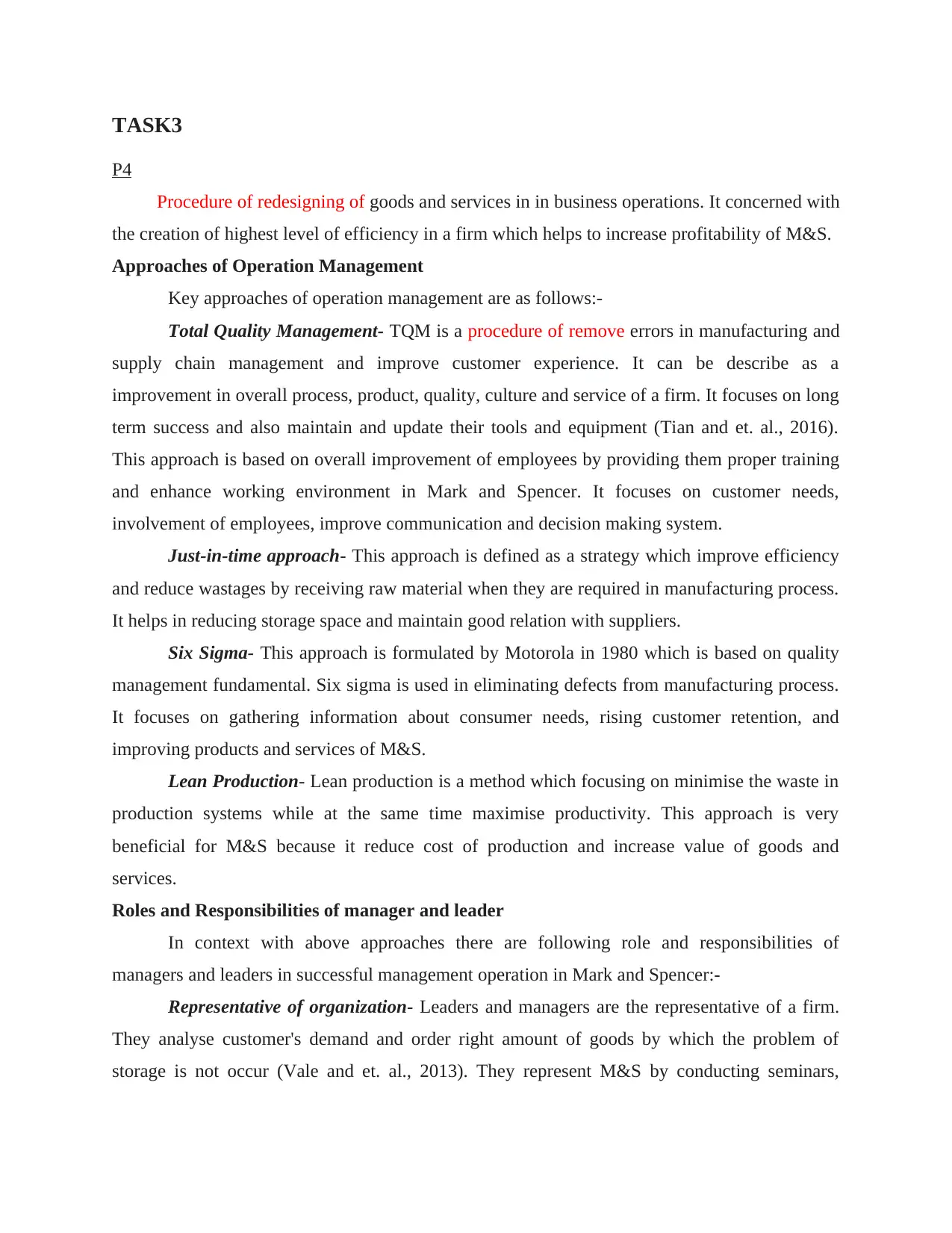
TASK3
P4
Procedure of redesigning of goods and services in in business operations. It concerned with
the creation of highest level of efficiency in a firm which helps to increase profitability of M&S.
Approaches of Operation Management
Key approaches of operation management are as follows:-
Total Quality Management- TQM is a procedure of remove errors in manufacturing and
supply chain management and improve customer experience. It can be describe as a
improvement in overall process, product, quality, culture and service of a firm. It focuses on long
term success and also maintain and update their tools and equipment (Tian and et. al., 2016).
This approach is based on overall improvement of employees by providing them proper training
and enhance working environment in Mark and Spencer. It focuses on customer needs,
involvement of employees, improve communication and decision making system.
Just-in-time approach- This approach is defined as a strategy which improve efficiency
and reduce wastages by receiving raw material when they are required in manufacturing process.
It helps in reducing storage space and maintain good relation with suppliers.
Six Sigma- This approach is formulated by Motorola in 1980 which is based on quality
management fundamental. Six sigma is used in eliminating defects from manufacturing process.
It focuses on gathering information about consumer needs, rising customer retention, and
improving products and services of M&S.
Lean Production- Lean production is a method which focusing on minimise the waste in
production systems while at the same time maximise productivity. This approach is very
beneficial for M&S because it reduce cost of production and increase value of goods and
services.
Roles and Responsibilities of manager and leader
In context with above approaches there are following role and responsibilities of
managers and leaders in successful management operation in Mark and Spencer:-
Representative of organization- Leaders and managers are the representative of a firm.
They analyse customer's demand and order right amount of goods by which the problem of
storage is not occur (Vale and et. al., 2013). They represent M&S by conducting seminars,
P4
Procedure of redesigning of goods and services in in business operations. It concerned with
the creation of highest level of efficiency in a firm which helps to increase profitability of M&S.
Approaches of Operation Management
Key approaches of operation management are as follows:-
Total Quality Management- TQM is a procedure of remove errors in manufacturing and
supply chain management and improve customer experience. It can be describe as a
improvement in overall process, product, quality, culture and service of a firm. It focuses on long
term success and also maintain and update their tools and equipment (Tian and et. al., 2016).
This approach is based on overall improvement of employees by providing them proper training
and enhance working environment in Mark and Spencer. It focuses on customer needs,
involvement of employees, improve communication and decision making system.
Just-in-time approach- This approach is defined as a strategy which improve efficiency
and reduce wastages by receiving raw material when they are required in manufacturing process.
It helps in reducing storage space and maintain good relation with suppliers.
Six Sigma- This approach is formulated by Motorola in 1980 which is based on quality
management fundamental. Six sigma is used in eliminating defects from manufacturing process.
It focuses on gathering information about consumer needs, rising customer retention, and
improving products and services of M&S.
Lean Production- Lean production is a method which focusing on minimise the waste in
production systems while at the same time maximise productivity. This approach is very
beneficial for M&S because it reduce cost of production and increase value of goods and
services.
Roles and Responsibilities of manager and leader
In context with above approaches there are following role and responsibilities of
managers and leaders in successful management operation in Mark and Spencer:-
Representative of organization- Leaders and managers are the representative of a firm.
They analyse customer's demand and order right amount of goods by which the problem of
storage is not occur (Vale and et. al., 2013). They represent M&S by conducting seminars,
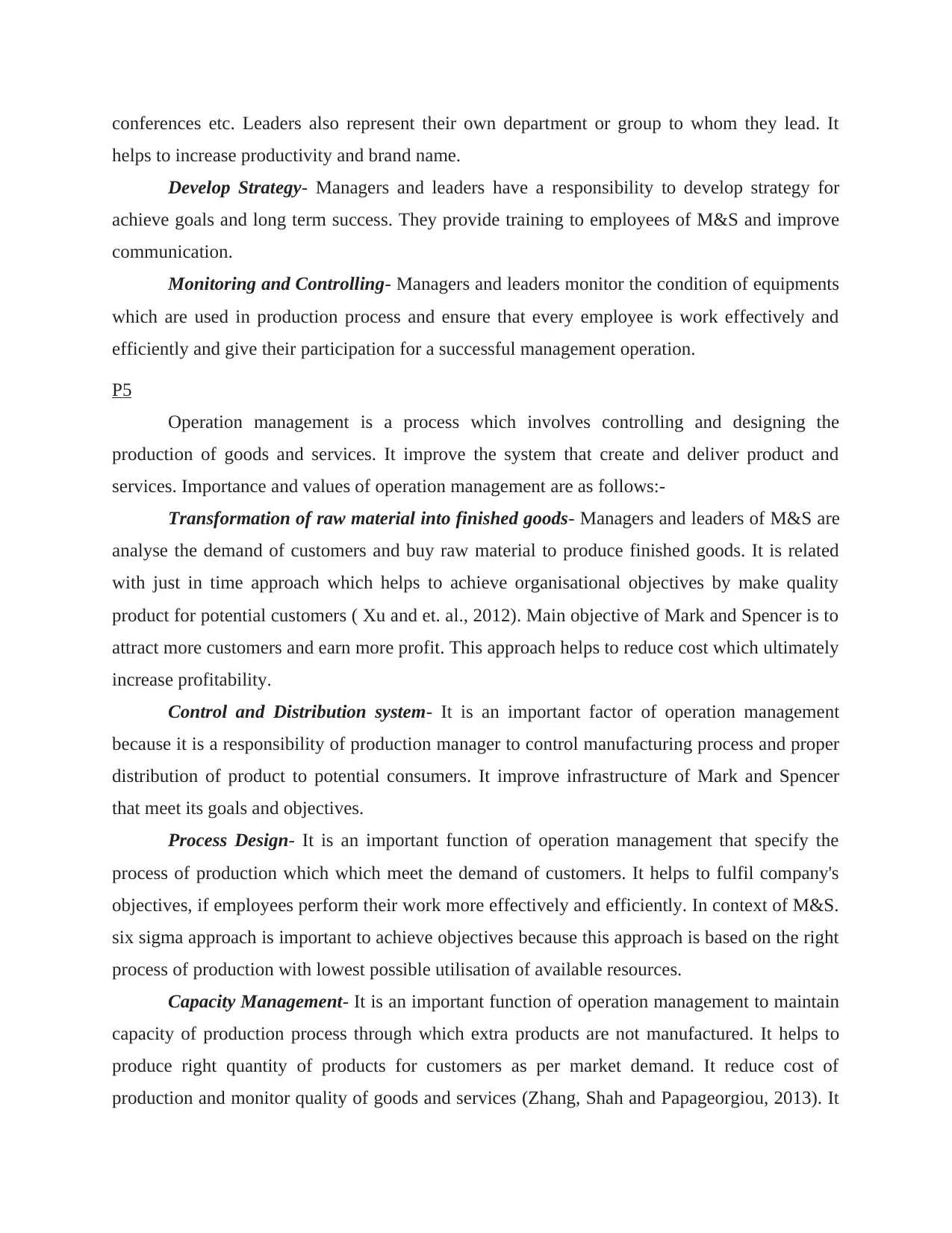
conferences etc. Leaders also represent their own department or group to whom they lead. It
helps to increase productivity and brand name.
Develop Strategy- Managers and leaders have a responsibility to develop strategy for
achieve goals and long term success. They provide training to employees of M&S and improve
communication.
Monitoring and Controlling- Managers and leaders monitor the condition of equipments
which are used in production process and ensure that every employee is work effectively and
efficiently and give their participation for a successful management operation.
P5
Operation management is a process which involves controlling and designing the
production of goods and services. It improve the system that create and deliver product and
services. Importance and values of operation management are as follows:-
Transformation of raw material into finished goods- Managers and leaders of M&S are
analyse the demand of customers and buy raw material to produce finished goods. It is related
with just in time approach which helps to achieve organisational objectives by make quality
product for potential customers ( Xu and et. al., 2012). Main objective of Mark and Spencer is to
attract more customers and earn more profit. This approach helps to reduce cost which ultimately
increase profitability.
Control and Distribution system- It is an important factor of operation management
because it is a responsibility of production manager to control manufacturing process and proper
distribution of product to potential consumers. It improve infrastructure of Mark and Spencer
that meet its goals and objectives.
Process Design- It is an important function of operation management that specify the
process of production which which meet the demand of customers. It helps to fulfil company's
objectives, if employees perform their work more effectively and efficiently. In context of M&S.
six sigma approach is important to achieve objectives because this approach is based on the right
process of production with lowest possible utilisation of available resources.
Capacity Management- It is an important function of operation management to maintain
capacity of production process through which extra products are not manufactured. It helps to
produce right quantity of products for customers as per market demand. It reduce cost of
production and monitor quality of goods and services (Zhang, Shah and Papageorgiou, 2013). It
helps to increase productivity and brand name.
Develop Strategy- Managers and leaders have a responsibility to develop strategy for
achieve goals and long term success. They provide training to employees of M&S and improve
communication.
Monitoring and Controlling- Managers and leaders monitor the condition of equipments
which are used in production process and ensure that every employee is work effectively and
efficiently and give their participation for a successful management operation.
P5
Operation management is a process which involves controlling and designing the
production of goods and services. It improve the system that create and deliver product and
services. Importance and values of operation management are as follows:-
Transformation of raw material into finished goods- Managers and leaders of M&S are
analyse the demand of customers and buy raw material to produce finished goods. It is related
with just in time approach which helps to achieve organisational objectives by make quality
product for potential customers ( Xu and et. al., 2012). Main objective of Mark and Spencer is to
attract more customers and earn more profit. This approach helps to reduce cost which ultimately
increase profitability.
Control and Distribution system- It is an important factor of operation management
because it is a responsibility of production manager to control manufacturing process and proper
distribution of product to potential consumers. It improve infrastructure of Mark and Spencer
that meet its goals and objectives.
Process Design- It is an important function of operation management that specify the
process of production which which meet the demand of customers. It helps to fulfil company's
objectives, if employees perform their work more effectively and efficiently. In context of M&S.
six sigma approach is important to achieve objectives because this approach is based on the right
process of production with lowest possible utilisation of available resources.
Capacity Management- It is an important function of operation management to maintain
capacity of production process through which extra products are not manufactured. It helps to
produce right quantity of products for customers as per market demand. It reduce cost of
production and monitor quality of goods and services (Zhang, Shah and Papageorgiou, 2013). It
⊘ This is a preview!⊘
Do you want full access?
Subscribe today to unlock all pages.

Trusted by 1+ million students worldwide
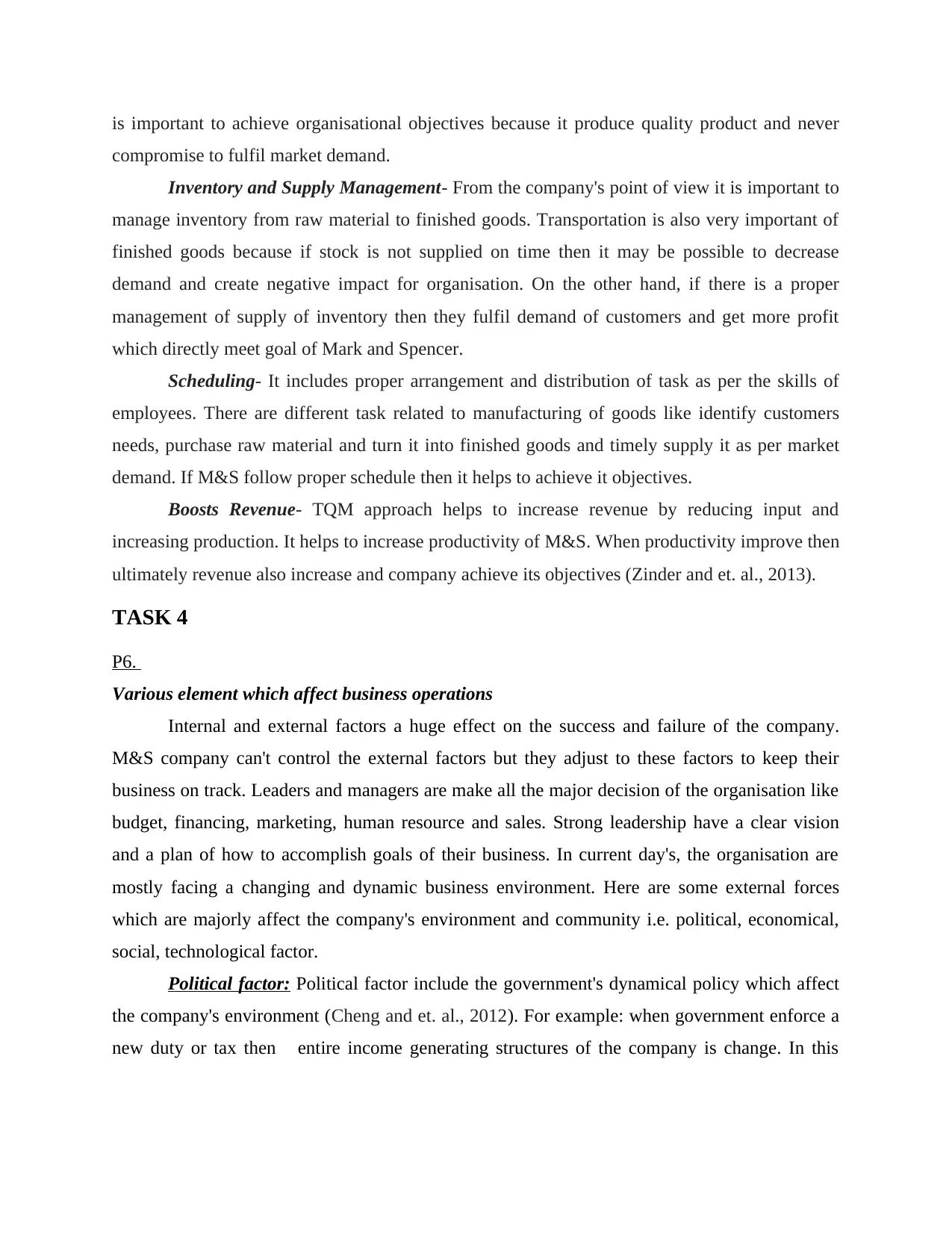
is important to achieve organisational objectives because it produce quality product and never
compromise to fulfil market demand.
Inventory and Supply Management- From the company's point of view it is important to
manage inventory from raw material to finished goods. Transportation is also very important of
finished goods because if stock is not supplied on time then it may be possible to decrease
demand and create negative impact for organisation. On the other hand, if there is a proper
management of supply of inventory then they fulfil demand of customers and get more profit
which directly meet goal of Mark and Spencer.
Scheduling- It includes proper arrangement and distribution of task as per the skills of
employees. There are different task related to manufacturing of goods like identify customers
needs, purchase raw material and turn it into finished goods and timely supply it as per market
demand. If M&S follow proper schedule then it helps to achieve it objectives.
Boosts Revenue- TQM approach helps to increase revenue by reducing input and
increasing production. It helps to increase productivity of M&S. When productivity improve then
ultimately revenue also increase and company achieve its objectives (Zinder and et. al., 2013).
TASK 4
P6.
Various element which affect business operations
Internal and external factors a huge effect on the success and failure of the company.
M&S company can't control the external factors but they adjust to these factors to keep their
business on track. Leaders and managers are make all the major decision of the organisation like
budget, financing, marketing, human resource and sales. Strong leadership have a clear vision
and a plan of how to accomplish goals of their business. In current day's, the organisation are
mostly facing a changing and dynamic business environment. Here are some external forces
which are majorly affect the company's environment and community i.e. political, economical,
social, technological factor.
Political factor: Political factor include the government's dynamical policy which affect
the company's environment (Cheng and et. al., 2012). For example: when government enforce a
new duty or tax then entire income generating structures of the company is change. In this
compromise to fulfil market demand.
Inventory and Supply Management- From the company's point of view it is important to
manage inventory from raw material to finished goods. Transportation is also very important of
finished goods because if stock is not supplied on time then it may be possible to decrease
demand and create negative impact for organisation. On the other hand, if there is a proper
management of supply of inventory then they fulfil demand of customers and get more profit
which directly meet goal of Mark and Spencer.
Scheduling- It includes proper arrangement and distribution of task as per the skills of
employees. There are different task related to manufacturing of goods like identify customers
needs, purchase raw material and turn it into finished goods and timely supply it as per market
demand. If M&S follow proper schedule then it helps to achieve it objectives.
Boosts Revenue- TQM approach helps to increase revenue by reducing input and
increasing production. It helps to increase productivity of M&S. When productivity improve then
ultimately revenue also increase and company achieve its objectives (Zinder and et. al., 2013).
TASK 4
P6.
Various element which affect business operations
Internal and external factors a huge effect on the success and failure of the company.
M&S company can't control the external factors but they adjust to these factors to keep their
business on track. Leaders and managers are make all the major decision of the organisation like
budget, financing, marketing, human resource and sales. Strong leadership have a clear vision
and a plan of how to accomplish goals of their business. In current day's, the organisation are
mostly facing a changing and dynamic business environment. Here are some external forces
which are majorly affect the company's environment and community i.e. political, economical,
social, technological factor.
Political factor: Political factor include the government's dynamical policy which affect
the company's environment (Cheng and et. al., 2012). For example: when government enforce a
new duty or tax then entire income generating structures of the company is change. In this
Paraphrase This Document
Need a fresh take? Get an instant paraphrase of this document with our AI Paraphraser

factors involve Fiscal policy, trade tariffs, tax policies, etc. and this affect the community and
environment of the company.
Economical factor: This factors determining the economy's performance that directly
influence the business of company and have long term effects. For example: if inflation rate is
rise then it has an impact on company's price and their goods and services. It also change the
demand, supply and purchasing power of the customers. In this factor include interest rate,
economic growth, inflation rate, foreign exchange rate etc.
Sociological factor: This factor relate to the beliefs, attitudes, culture aspects that affect
the demand and supply for the company's services and products. For example: If consumers'
beliefs are change then demand of products is decrease and that also affect the company's
process. In this factor include demographics, lifestyle trends, work ethics, customers opinions
and attitudes, buying trends and access etc. that affects the M&S company's environment and
community.
Technological factor: When technology is change and innovation in technology take
place then it mainly affects the company's manufacturing process and its leads to unproductive of
workers (Fayol, 2016). In this include technology legislation, development of competitor
technology, research and innovation, maturity of technology etc.
Suggestions: Managers of M&S company should be analysis and evaluate all the
external factors which affect the company. If they analysis the factors in advance and already
prepare for the new changes, then no challenges and problems are face by the company in
future.
CONCLUSION
From the above discussion it has been conclude that managers and leaders have different
roles and characteristics and they follow their roles very efficiently. There are different
managerial function like planning, organising, staffing, directing and controlling and different
theories, situational, system and contingency leadership theory which helps organisation to
support growth and sustainable performance. Managers and leaders also play an important role to
for future improvements by analysing and managing all the activities in M&S. There are
different approaches of operation management, which is adopted by firm. M&S use TQM, just-
in-time, six sigma and line production approach to achieve organisational objectives. There are
so many importance of key approaches which helps to increase productivity and optimum
environment of the company.
Economical factor: This factors determining the economy's performance that directly
influence the business of company and have long term effects. For example: if inflation rate is
rise then it has an impact on company's price and their goods and services. It also change the
demand, supply and purchasing power of the customers. In this factor include interest rate,
economic growth, inflation rate, foreign exchange rate etc.
Sociological factor: This factor relate to the beliefs, attitudes, culture aspects that affect
the demand and supply for the company's services and products. For example: If consumers'
beliefs are change then demand of products is decrease and that also affect the company's
process. In this factor include demographics, lifestyle trends, work ethics, customers opinions
and attitudes, buying trends and access etc. that affects the M&S company's environment and
community.
Technological factor: When technology is change and innovation in technology take
place then it mainly affects the company's manufacturing process and its leads to unproductive of
workers (Fayol, 2016). In this include technology legislation, development of competitor
technology, research and innovation, maturity of technology etc.
Suggestions: Managers of M&S company should be analysis and evaluate all the
external factors which affect the company. If they analysis the factors in advance and already
prepare for the new changes, then no challenges and problems are face by the company in
future.
CONCLUSION
From the above discussion it has been conclude that managers and leaders have different
roles and characteristics and they follow their roles very efficiently. There are different
managerial function like planning, organising, staffing, directing and controlling and different
theories, situational, system and contingency leadership theory which helps organisation to
support growth and sustainable performance. Managers and leaders also play an important role to
for future improvements by analysing and managing all the activities in M&S. There are
different approaches of operation management, which is adopted by firm. M&S use TQM, just-
in-time, six sigma and line production approach to achieve organisational objectives. There are
so many importance of key approaches which helps to increase productivity and optimum
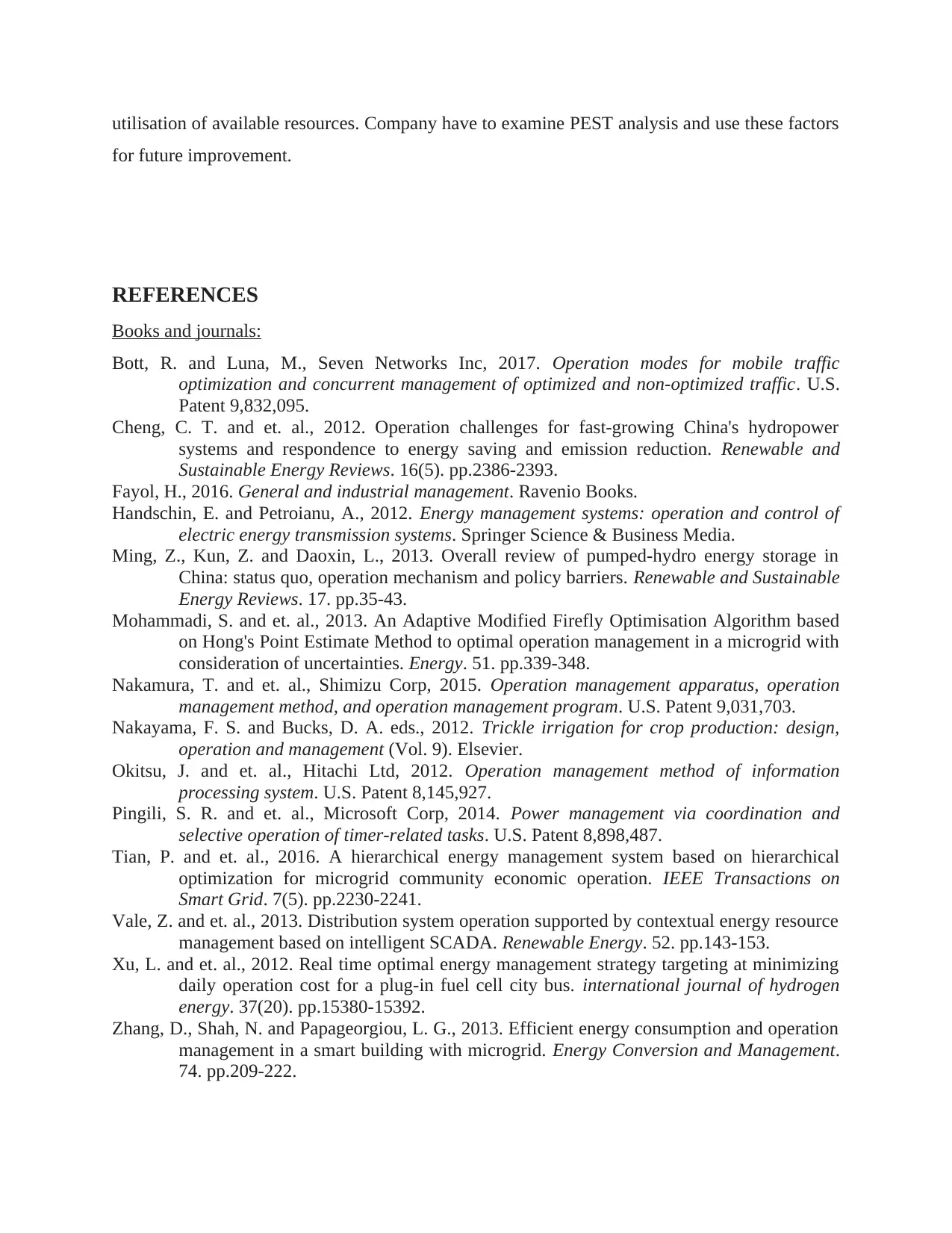
utilisation of available resources. Company have to examine PEST analysis and use these factors
for future improvement.
REFERENCES
Books and journals:
Bott, R. and Luna, M., Seven Networks Inc, 2017. Operation modes for mobile traffic
optimization and concurrent management of optimized and non-optimized traffic. U.S.
Patent 9,832,095.
Cheng, C. T. and et. al., 2012. Operation challenges for fast-growing China's hydropower
systems and respondence to energy saving and emission reduction. Renewable and
Sustainable Energy Reviews. 16(5). pp.2386-2393.
Fayol, H., 2016. General and industrial management. Ravenio Books.
Handschin, E. and Petroianu, A., 2012. Energy management systems: operation and control of
electric energy transmission systems. Springer Science & Business Media.
Ming, Z., Kun, Z. and Daoxin, L., 2013. Overall review of pumped-hydro energy storage in
China: status quo, operation mechanism and policy barriers. Renewable and Sustainable
Energy Reviews. 17. pp.35-43.
Mohammadi, S. and et. al., 2013. An Adaptive Modified Firefly Optimisation Algorithm based
on Hong's Point Estimate Method to optimal operation management in a microgrid with
consideration of uncertainties. Energy. 51. pp.339-348.
Nakamura, T. and et. al., Shimizu Corp, 2015. Operation management apparatus, operation
management method, and operation management program. U.S. Patent 9,031,703.
Nakayama, F. S. and Bucks, D. A. eds., 2012. Trickle irrigation for crop production: design,
operation and management (Vol. 9). Elsevier.
Okitsu, J. and et. al., Hitachi Ltd, 2012. Operation management method of information
processing system. U.S. Patent 8,145,927.
Pingili, S. R. and et. al., Microsoft Corp, 2014. Power management via coordination and
selective operation of timer-related tasks. U.S. Patent 8,898,487.
Tian, P. and et. al., 2016. A hierarchical energy management system based on hierarchical
optimization for microgrid community economic operation. IEEE Transactions on
Smart Grid. 7(5). pp.2230-2241.
Vale, Z. and et. al., 2013. Distribution system operation supported by contextual energy resource
management based on intelligent SCADA. Renewable Energy. 52. pp.143-153.
Xu, L. and et. al., 2012. Real time optimal energy management strategy targeting at minimizing
daily operation cost for a plug-in fuel cell city bus. international journal of hydrogen
energy. 37(20). pp.15380-15392.
Zhang, D., Shah, N. and Papageorgiou, L. G., 2013. Efficient energy consumption and operation
management in a smart building with microgrid. Energy Conversion and Management.
74. pp.209-222.
for future improvement.
REFERENCES
Books and journals:
Bott, R. and Luna, M., Seven Networks Inc, 2017. Operation modes for mobile traffic
optimization and concurrent management of optimized and non-optimized traffic. U.S.
Patent 9,832,095.
Cheng, C. T. and et. al., 2012. Operation challenges for fast-growing China's hydropower
systems and respondence to energy saving and emission reduction. Renewable and
Sustainable Energy Reviews. 16(5). pp.2386-2393.
Fayol, H., 2016. General and industrial management. Ravenio Books.
Handschin, E. and Petroianu, A., 2012. Energy management systems: operation and control of
electric energy transmission systems. Springer Science & Business Media.
Ming, Z., Kun, Z. and Daoxin, L., 2013. Overall review of pumped-hydro energy storage in
China: status quo, operation mechanism and policy barriers. Renewable and Sustainable
Energy Reviews. 17. pp.35-43.
Mohammadi, S. and et. al., 2013. An Adaptive Modified Firefly Optimisation Algorithm based
on Hong's Point Estimate Method to optimal operation management in a microgrid with
consideration of uncertainties. Energy. 51. pp.339-348.
Nakamura, T. and et. al., Shimizu Corp, 2015. Operation management apparatus, operation
management method, and operation management program. U.S. Patent 9,031,703.
Nakayama, F. S. and Bucks, D. A. eds., 2012. Trickle irrigation for crop production: design,
operation and management (Vol. 9). Elsevier.
Okitsu, J. and et. al., Hitachi Ltd, 2012. Operation management method of information
processing system. U.S. Patent 8,145,927.
Pingili, S. R. and et. al., Microsoft Corp, 2014. Power management via coordination and
selective operation of timer-related tasks. U.S. Patent 8,898,487.
Tian, P. and et. al., 2016. A hierarchical energy management system based on hierarchical
optimization for microgrid community economic operation. IEEE Transactions on
Smart Grid. 7(5). pp.2230-2241.
Vale, Z. and et. al., 2013. Distribution system operation supported by contextual energy resource
management based on intelligent SCADA. Renewable Energy. 52. pp.143-153.
Xu, L. and et. al., 2012. Real time optimal energy management strategy targeting at minimizing
daily operation cost for a plug-in fuel cell city bus. international journal of hydrogen
energy. 37(20). pp.15380-15392.
Zhang, D., Shah, N. and Papageorgiou, L. G., 2013. Efficient energy consumption and operation
management in a smart building with microgrid. Energy Conversion and Management.
74. pp.209-222.
⊘ This is a preview!⊘
Do you want full access?
Subscribe today to unlock all pages.

Trusted by 1+ million students worldwide
1 out of 13
Related Documents
Your All-in-One AI-Powered Toolkit for Academic Success.
+13062052269
info@desklib.com
Available 24*7 on WhatsApp / Email
![[object Object]](/_next/static/media/star-bottom.7253800d.svg)
Unlock your academic potential
Copyright © 2020–2025 A2Z Services. All Rights Reserved. Developed and managed by ZUCOL.





